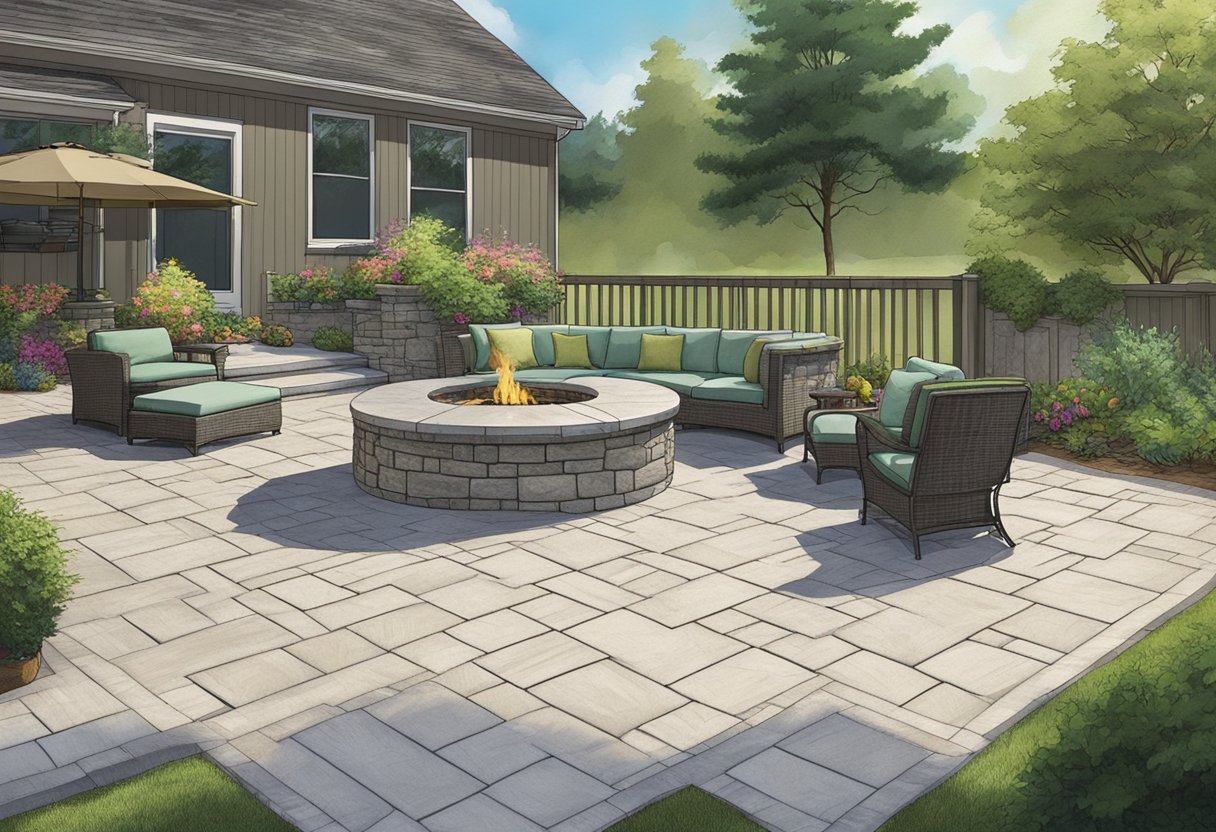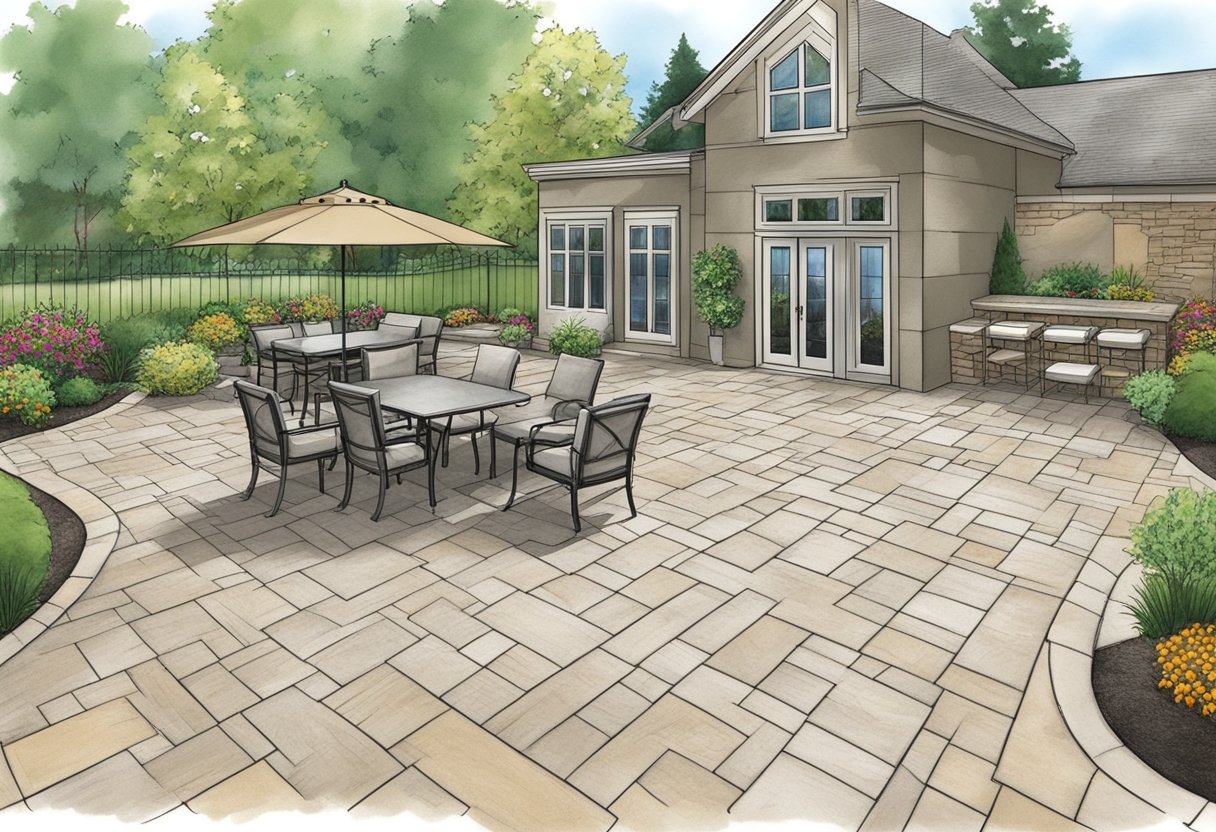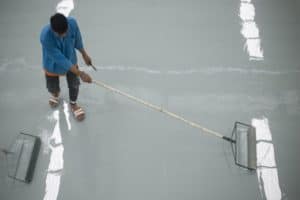Stamped concrete patios and pavers are two popular choices for outdoor living spaces. Both materials offer a range of benefits and can be customized to fit various styles and preferences. Stamped concrete patios are created by pouring concrete and then stamping a pattern onto the surface to create a textured and decorative look. Pavers, on the other hand, are individual pieces of concrete, brick, or stone that are laid in a specific pattern to create a cohesive surface.

When considering a new patio, one of the first decisions to make is which material to use. Stamped concrete patios and pavers both have their advantages and disadvantages. Stamped concrete patios are typically less expensive than pavers and can be customized to mimic the look of other materials such as stone or brick. Pavers, on the other hand, offer more design flexibility and can be easily replaced if damaged. Ultimately, the decision between stamped concrete patios and pavers will depend on a variety of factors, including budget, style preferences, and maintenance requirements.
Understanding the Basics
Stamped concrete and pavers are two of the most popular options for outdoor patios. Both offer a range of benefits and come in various styles, designs, and colors. Understanding the basics of each material can help homeowners make an informed decision when choosing between the two.
What Is Stamped Concrete?
Stamped concrete is a type of concrete that is patterned and textured to resemble other materials such as brick, flagstone, natural stone, cobblestone, slate, wood, and tile. The process involves pouring concrete onto a surface and then stamping it with a mold to create a pattern. The result is a durable and low-maintenance surface that looks like a more expensive material.
Stamped concrete is highly customizable, allowing homeowners to choose from a wide range of patterns and colors. It is also durable and long-lasting, making it an excellent choice for outdoor patios. Additionally, stamped concrete is low-maintenance, requiring only occasional sealing to protect it from the elements.
What Are Pavers?
Pavers are individual pieces of stone, concrete, or brick that are laid in a pattern to create a surface. They come in a variety of shapes, sizes, and colors, making them highly customizable. Pavers are durable and long-lasting, making them an excellent choice for outdoor patios.
One of the benefits of pavers is that they are easy to repair. If one paver becomes damaged, it can be removed and replaced without affecting the rest of the surface. Additionally, pavers are slip-resistant, making them a safe choice for outdoor patios.
In summary, stamped concrete and pavers are two popular options for outdoor patios. Stamped concrete is a type of concrete that is patterned and textured to resemble other materials, while pavers are individual pieces of stone, concrete, or brick that are laid in a pattern to create a surface. Both offer a range of benefits and come in various styles, designs, and colors.
Design and Aesthetic Considerations
When it comes to designing an outdoor space, the choice between a stamped concrete patio and pavers can be a tough one. Both options offer a range of design possibilities that can complement any home’s exterior. Here are some design and aesthetic considerations to keep in mind when making your decision.
Patterns and Textures
One of the advantages of stamped concrete is the wide range of patterns and textures available. Homeowners can choose from a variety of designs that mimic natural stone, brick, or tile. Pavers, on the other hand, offer versatility in design and can be easily replaced or rearranged. They come in a variety of shapes and sizes, allowing for a truly customized look.
Color Options
Stamped concrete patios and pavers offer a range of color options to choose from. Concrete can be stained to achieve a variety of shades, including earth tones and vibrant colors. Pavers, on the other hand, come in a variety of natural colors, such as beige, gray, and brown.
Customizable Designs
Both stamped concrete and pavers offer customizable designs that can be tailored to fit any style. Homeowners can choose from a variety of patterns, textures, and colors to create a unique look that complements their home’s exterior. With stamped concrete, homeowners can also add custom designs, such as logos or images, to create a truly personalized space.
In summary, both stamped concrete patios and pavers offer a range of design possibilities that can enhance any outdoor space. Stamped concrete offers a wide range of patterns and textures, while pavers offer versatility in design and can be easily replaced or rearranged. Both options offer a variety of color options and customizable designs, allowing homeowners to create a truly unique look.
Installation Insights
Preparing the Foundation
Before installing either stamped concrete or pavers, the foundation must be prepared properly. The foundation is the base layer that will support the weight of the patio and prevent it from shifting or cracking. For both stamped concrete and pavers, the foundation must be compacted and leveled. However, the type of foundation material used may differ. For stamped concrete, a layer of gravel is typically used as the foundation. On the other hand, pavers require a layer of sand and gravel to create a stable base.
Installation Process
The installation process for stamped concrete and pavers is different. Stamped concrete is poured onto the foundation and then stamped with a pattern to create the desired look. Pavers, on the other hand, are laid individually on top of the foundation and then interlocked together. The installation process for stamped concrete can be more labor-intensive, as it requires pouring and stamping the concrete, whereas pavers can be laid by hand without any special tools or equipment.
Installation Time
The installation time for stamped concrete and pavers can vary depending on the size of the patio and the complexity of the design. Generally, stamped concrete can be installed faster than pavers because it is poured and stamped as a single slab. Pavers, on the other hand, require individual placement and interlocking. However, the installation time for stamped concrete can be longer if the design is complex or if there are multiple colors or patterns.
In terms of labor, stamped concrete requires more skilled labor than pavers. This is because the pouring and stamping process requires experience and precision to achieve the desired result. On the other hand, pavers can be installed by anyone with basic DIY skills, making them a popular choice for homeowners who want to save on installation costs.
Overall, the installation process for stamped concrete and pavers has its own unique advantages and disadvantages. Homeowners should consider their budget, desired design, and installation time before making a decision.
Cost Analysis

When it comes to deciding between a stamped concrete patio and pavers, cost is a significant factor to consider. In this section, we will analyze the cost of both options to help you make an informed decision.
Initial Investment
The initial cost of stamped concrete is generally lower than that of pavers. Stamped concrete is poured in place, which makes it less labor-intensive than pavers. Additionally, since pavers are individual pieces that need to be laid out, the installation process takes longer and requires more labor. However, the cost of pavers has been decreasing in recent years, making them more affordable for homeowners.
Cost Per Square Foot
The cost per square foot of a stamped concrete patio is generally lower than that of pavers. According to Bob Vila, the cost of stamped concrete ranges from $8 to $12 per square foot, while pavers cost between $10 and $30 per square foot. However, it’s important to note that the cost of installation can vary depending on factors such as the complexity of the design and the size of the project.
Long-Term Value
When it comes to long-term value, pavers have the advantage over stamped concrete. Pavers are more durable and can last for decades with proper maintenance. Additionally, pavers have a higher resale value than stamped concrete, which can be a significant factor if you plan on selling your home in the future.
On the other hand, stamped concrete requires less maintenance than pavers. While pavers need to be re-leveled and re-sanded periodically, stamped concrete only needs to be sealed every few years. However, if stamped concrete cracks or becomes damaged, repair costs can be higher than those of pavers.
Overall, the decision between a stamped concrete patio and pavers depends on your budget, design preferences, and long-term goals. While stamped concrete is more affordable initially, pavers offer more long-term value and durability.
Durability and Maintenance

Stamped concrete and pavers both offer excellent durability and require minimal maintenance. However, there are some differences in how they weather and wear over time, as well as how they can be repaired and replaced.
Weathering and Wear
Both stamped concrete and pavers can withstand a range of weather conditions, including freeze-thaw cycles and heavy foot traffic. However, pavers tend to be more durable and can withstand more wear and tear than stamped concrete. Stamped concrete can crack over time, especially if it is exposed to extreme temperatures or heavy loads.
Repair and Replacement
One advantage of stamped concrete is that it can be repaired fairly easily. Small cracks can be filled with a patching compound, while larger cracks may require the entire surface to be resurfaced. Pavers, on the other hand, are more difficult to repair because they are individual units. If a paver becomes damaged, it must be removed and replaced with a new one.
Sealing and Upkeep
Both stamped concrete and pavers benefit from regular sealing to help protect them from the elements and keep them looking their best. Stamped concrete should be resealed every 2-3 years, while pavers should be resealed every 3-5 years. In addition, both stamped concrete and pavers should be cleaned regularly with a pressure washer to remove dirt and debris.
To enhance their slip resistance, stamped concrete and pavers can also be treated with a slip-resistant coating. This is especially important if the patio or driveway is located in an area that receives a lot of rain or snow.
Overall, both stamped concrete and pavers offer excellent durability and require minimal maintenance. However, pavers tend to be more durable and can withstand more wear and tear than stamped concrete. Additionally, stamped concrete is easier to repair, while pavers are more difficult to repair but offer the advantage of individual units that can be replaced if damaged.
Comparing Pros and Cons
Advantages of Stamped Concrete
Stamped concrete has become increasingly popular for patios and driveways due to its versatility, durability, and aesthetic appeal. One of the main advantages of stamped concrete is the wide range of patterns and colors available, which can mimic the look of natural stone, brick, or wood. Stamped concrete is also an affordable option compared to other materials, such as pavers. Additionally, stamped concrete is relatively low-maintenance and can last for many years with proper care.
Benefits of Pavers
Pavers are another popular option for patios and driveways, offering a range of benefits over stamped concrete. One of the main advantages of pavers is their durability and ability to withstand heavy foot traffic and freeze-thaw cycles. Pavers are also available in a wide range of colors and patterns, allowing for customization to match any home’s aesthetic. Additionally, pavers can be easily replaced if damaged, unlike stamped concrete.
Limitations and Challenges
While both stamped concrete and pavers offer a range of benefits, there are also limitations and challenges to consider when choosing between the two. Stamped concrete can be prone to cracking over time, especially in areas with heavy foot traffic or extreme weather conditions. Additionally, stamped concrete can be slippery when wet, which can be a safety hazard. On the other hand, pavers can be more expensive than stamped concrete and require more maintenance, such as regular cleaning and sealing.
When considering the cost-effectiveness of each option, stamped concrete tends to be a more affordable choice initially. However, pavers may be a better long-term investment due to their durability and ability to be easily replaced. When it comes to weight-bearing, pavers tend to be a better option for heavy vehicles or equipment, while stamped concrete may be more suitable for lighter use.
Overall, the decision between stamped concrete and pavers comes down to personal preference, budget, and the specific needs of the project. It is important to weigh the pros and cons of each option and consult with a professional to determine the best choice for your home.
Environmental and Safety Considerations

Permeable Options
When it comes to environmental considerations, permeable pavements are a great option for those who want to reduce their carbon footprint. Permeable pavers are designed to allow water to pass through them and into the soil, which can help to reduce runoff and prevent flooding. In contrast, stamped concrete patios do not allow water to pass through them, which can contribute to runoff and pollution.
Permeable pavers are also a great option for those who live in areas that experience heavy rainfall. By allowing water to pass through them, permeable pavers can help to prevent flooding and erosion. Additionally, permeable pavers can help to reduce the urban heat island effect by allowing water to evaporate from their surface.
Safety Features
When it comes to safety considerations, slip-resistant coatings are an important feature to consider. Stamped concrete patios can be slippery when wet, which can be a safety hazard for those who use them. To reduce this risk, slip-resistant coatings can be applied to stamped concrete patios to help improve traction.
In contrast, pavers are naturally slip-resistant due to their textured surface. Additionally, many pavers are designed with beveled edges, which can help to reduce tripping hazards.
Overall, when it comes to environmental and safety considerations, permeable pavers and slip-resistant coatings are great options to consider. By choosing these options, homeowners can help to reduce their carbon footprint and improve the safety of their outdoor living space.
Selecting Contractors and Materials
Choosing the Right Contractor
Selecting the right contractor is crucial to ensure that your patio is built to your satisfaction. When choosing a contractor, it is important to consider their experience, reputation, and credentials. A reputable contractor should have a portfolio of completed projects that you can review to ensure that they have experience in building patios with the materials you have selected.
It is also important to check references and read reviews from previous clients to ensure that the contractor has a good track record. Asking for a written estimate and contract is also recommended to ensure that the project is completed within the agreed-upon budget and timeline.
Material Quality and Sources
The quality of the materials used in building your patio is another important consideration. The quality of the concrete blocks or pavers used can impact the durability and longevity of your patio. It is recommended to choose high-quality materials that are sourced from reputable manufacturers.
Additionally, the sealer used on the patio can also impact its longevity and appearance. It is important to choose a high-quality sealer that is appropriate for the materials used in your patio. A reputable contractor should be able to recommend the best sealer for your patio and apply it correctly.
In summary, selecting the right contractor and materials is essential to ensure that your stamped concrete patio or pavers are built to your satisfaction and last for years to come. By taking the time to research and select the right contractor and materials, you can ensure that your patio is built to the highest standards.
Additional Applications
Walkways and Driveways
Stamped concrete and pavers are not only suitable for patios. They can also be used for walkways and driveways. In fact, many homeowners prefer to have their walkways and driveways made of stamped concrete or pavers because of their durability and aesthetic appeal.
When it comes to walkways, stamped concrete is a popular choice because it can be designed to mimic the look of natural stone, slate, or brick. It is also slip-resistant, making it a safer option, especially during wet weather conditions.
For driveways, both stamped concrete and pavers are excellent choices. Stamped concrete is known for its durability, and it can withstand heavy traffic and extreme weather conditions. On the other hand, pavers are also durable and can be easily replaced if damaged.
Comparisons with Other Materials
When it comes to walkways and driveways, there are other materials that homeowners can choose from, such as asphalt and concrete.
Compared to asphalt, stamped concrete and pavers are more durable and can last longer. Asphalt typically lasts for about 20 years, while stamped concrete and pavers can last for up to 30 years or more with proper maintenance.
Concrete is also a popular choice for driveways, but it can be more expensive than stamped concrete. The cost of a concrete driveway can range from $3 to $10 per square foot, while stamped concrete costs between $8 and $12 per square foot. However, stamped concrete can mimic the look of more expensive materials, such as slate pavers, at a fraction of the cost.
Another material that is gaining popularity for walkways and driveways is Techo-Bloc. Techo-Bloc is a high-end paving stone that is known for its durability and aesthetic appeal. However, it can be more expensive than stamped concrete and pavers, with costs ranging from $10 to $20 per square foot.
Overall, stamped concrete and pavers are excellent choices for walkways and driveways due to their durability, aesthetic appeal, and versatility. Homeowners can choose from a variety of designs and patterns to create a unique look that complements their home’s architecture.


